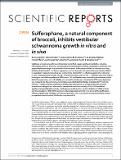Sulforaphane, a natural component of broccoli, inhibits vestibular schwannoma growth in vitro and in vivo

View/
Author
Kim, Bo Gyung
Fujita, Takeshi
Moon, In Seok
Choi, Jae Young
Yun, Jieun
Kang, Jong Soon
Lee, Jong Dae
Published Version
https://doi.org/10.1038/srep36215Metadata
Show full item recordCitation
Kim, Bo Gyung, Takeshi Fujita, Konstantina M. Stankovic, D. Bradley Welling, In Seok Moon, Jae Young Choi, Jieun Yun, Jong Soon Kang, and Jong Dae Lee. 2016. “Sulforaphane, a natural component of broccoli, inhibits vestibular schwannoma growth in vitro and in vivo.” Scientific Reports 6 (1): 36215. doi:10.1038/srep36215. http://dx.doi.org/10.1038/srep36215.Abstract
Vestibular schwannoma (VS) is an intracranial tumor that causes significant morbidity, including hearing loss, tinnitus, dizziness, and possibly even death from brainstem compression. However, FDA-approved pharmacologic treatments for VS do not exist. Sulforaphane (SFN) is a naturally occurring isothiocyanate found in cruciferous vegetables, such as broccoli, with potent chemoprotective effects in several cell types. Our objective was to determine whether SFN is effective against VS in vitro and in vivo. Human primary VS cells, HEI-193 schwannoma cells, and SC4 Nf2−/− Schwann cells were used to investigate the inhibitory effects of SFN in vitro. Cell proliferation was assessed by bromodeoxyuridine (BrdU) incorporation, and cell viability and metabolic activity was calculated by MTT assay. Apoptosis was measured by flow cytometry, terminal deoxynucleotidyl transferase-mediated dUTP nick end labeling (TUNEL) staining, and Western blot for cleaved caspases. A mouse model with a murine schwannoma allograft was also used to examine the antitumor activity of SFN. SFN exhibited significant antiproliferative activity in schwannoma cells in vitro, via the inhibition of HDAC activity and the activation of ERK. SFN treatment induced apoptosis and cell cycle arrest at the G2/M phase. SFN also significantly inhibited schwannoma growth in vivo. Our preclinical studies motivate a future prospective clinical study of SFN for the treatment of VS.Other Sources
http://www.ncbi.nlm.nih.gov/pmc/articles/PMC5090244/pdf/Terms of Use
This article is made available under the terms and conditions applicable to Other Posted Material, as set forth at http://nrs.harvard.edu/urn-3:HUL.InstRepos:dash.current.terms-of-use#LAACitable link to this page
http://nrs.harvard.edu/urn-3:HUL.InstRepos:29626096
Collections
- HMS Scholarly Articles [17922]
Contact administrator regarding this item (to report mistakes or request changes)


